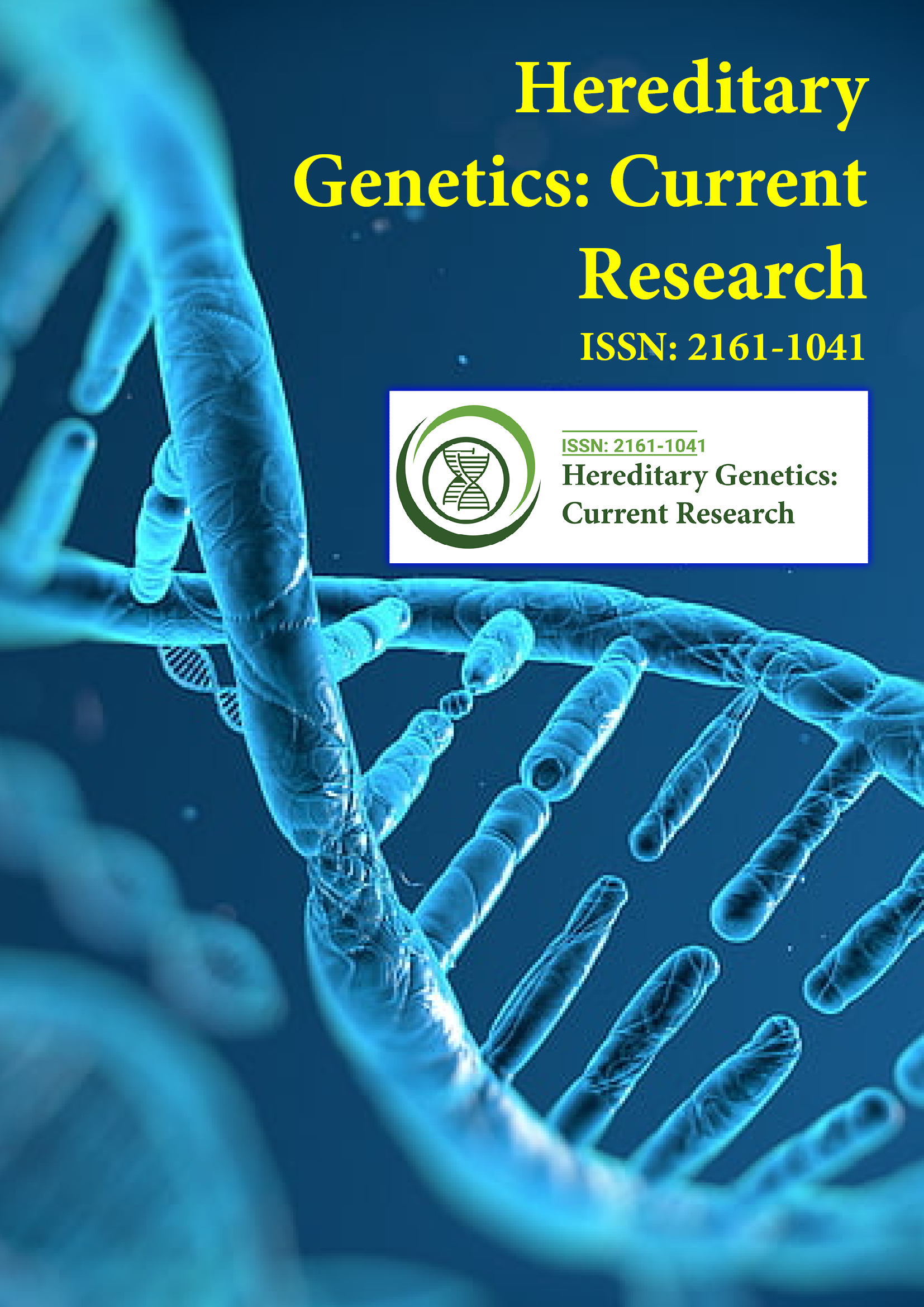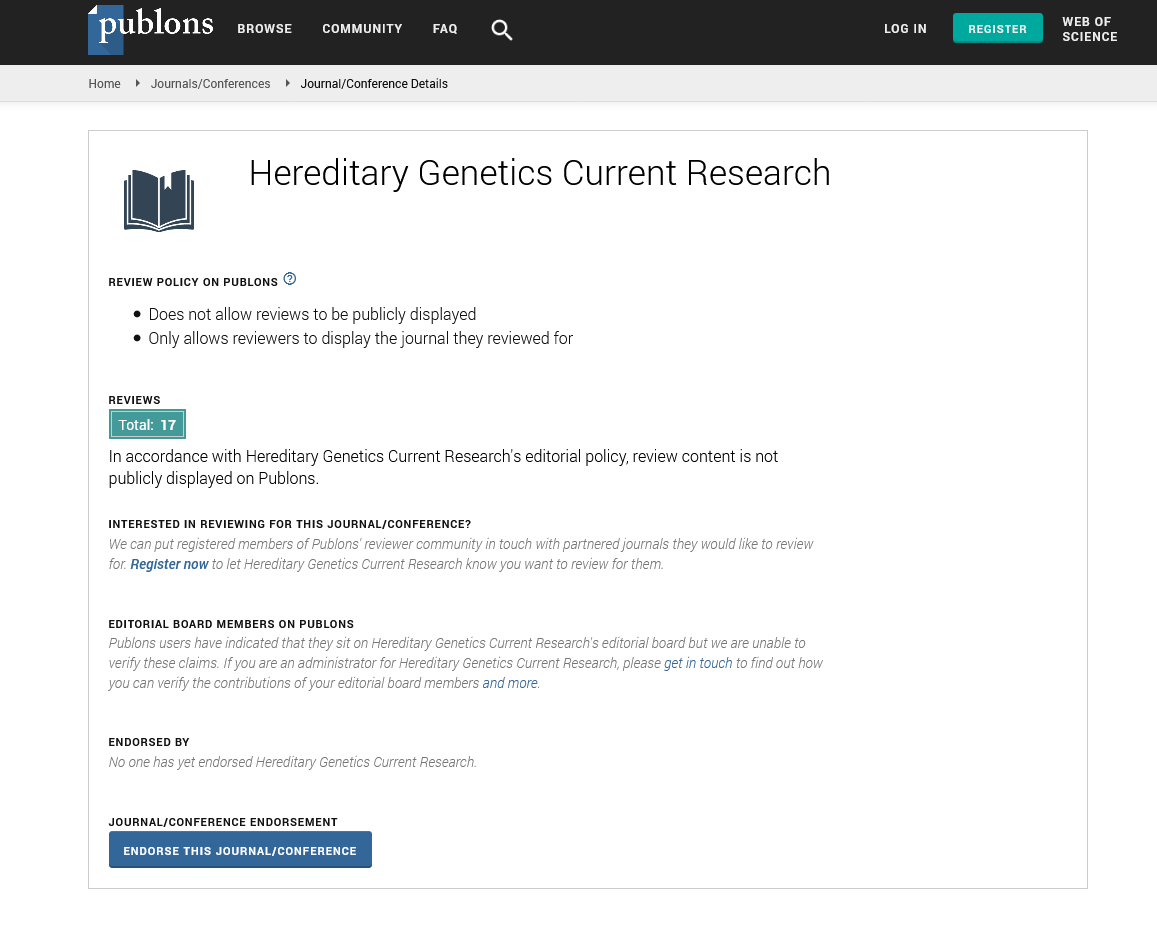Indexed In
- Open J Gate
- Genamics JournalSeek
- CiteFactor
- RefSeek
- Hamdard University
- EBSCO A-Z
- NSD - Norwegian Centre for Research Data
- OCLC- WorldCat
- Publons
- Geneva Foundation for Medical Education and Research
- Euro Pub
- Google Scholar
Useful Links
Share This Page
Journal Flyer

Open Access Journals
- Agri and Aquaculture
- Biochemistry
- Bioinformatics & Systems Biology
- Business & Management
- Chemistry
- Clinical Sciences
- Engineering
- Food & Nutrition
- General Science
- Genetics & Molecular Biology
- Immunology & Microbiology
- Medical Sciences
- Neuroscience & Psychology
- Nursing & Health Care
- Pharmaceutical Sciences
Commentary - (2022) Volume 11, Issue 2
Drug Transporters on Genetic Polymorphisms and its Consequences in Pharmacotherapy
Hazenberg Karaca*Received: 01-Mar-2022, Manuscript No. HGCR-22-16430; Editor assigned: 04-Mar-2022, Pre QC No. HGCR-22-16430 (PQ); Reviewed: 18-Mar-2022, QC No. HGCR-22-16430; Revised: 25-Mar-2022, Manuscript No. HGCR-22-16430 (R); Published: 04-Apr-2022, DOI: 10.35248/2161-1041.22.11.208
Description
Drug transporters play an important role in the Absorption, Distribution, and Elimination (ADE) of many drugs. In recent years, it has become increasingly clear that there are significant differences in substrate specificity, tissue distribution, and relative abundance of transporters among rodents, dogs, monkeys, and humans. These differences complicate extrapolation between different species. This is important for predicting the human Pharmacokinetics (PK) of drug candidates and assessing the risk of Drug-Drug Interactions (DDI). The role of drug transporters in pharmacokinetic and pharmacodynamics outcomes in pharmacotherapy is increasingly recognized. The clinical relevance of drug transporters depends on localization in human tissues, the therapeutic index of the substrate, and inherent inter-individual variability.
In terms of variability, it was recently reported that drug transporter gene polymorphisms are associated with changes in the pharmacokinetics and pharmacodynamics of clinically useful drugs. More and more preclinical and clinical studies have shown that the application of genetic information may be useful in individual drug therapies for many diseases. However, the reported effects of mutations in certain drug transporter genes were inconsistent studies. In addition, the development of almost all known variants of the transporter gene tends to be breed-dependent. These observations suggest that inter-ethnic variability should be considered before extrapolating pharmacokinetic data from one ethnic group to another, especially in the early stages of drug development. This review focuses on the impact of genetic variations in the function of drug transporters. The implications of these variations are for pharmacotherapy, pharmacokinetic and pharmacodynamics viewpoints. Organic Anion Transporting Polypeptide (OATP) 1B1 and OATP1B3 is uptake transporters, specifically expressed in the liver, and considered important for drugs, particularly as their pharmacological target organ is the liver.
Two ATP binding transporters, multidrug resistance associated protein and breast cancer resistance protein, are efflux transporters, expressed in various human tissues, and considered particularly important for intestinal drug absorption and hepatic drug elimination. All 3 hydroxyl 3 methylglutarylCoA reductase inhibitors (statins) except fluvastatin are substrates for OATP1B1, but hepatobiliary (canalicular) efflux transporters differ among statins. In this review, we update the pharmacogenomics/pharmacokinetic properties of these transporters and their effects on PK/PD profiles of statins and other clinically relevant drugs. In addition, we describe a physiology-based pharmacokinetic model for predicting the effects of changes in transporter activity on systemic and hepatic pravastatin exposure. Drug cocktails are used clinically to assess the potential for Drug Interactions (DDI), especially DDI resulting from the co-administration of a substrate and an inhibitor of the cytochrome P450 enzyme.
To investigate the potential for DDI caused by inhibition of major transporters, we propose a cocktail of the following substrates: digoxin, losbustatin (Breast Cancer Resistant Protein, BCRP; organic anion transport poly): Peptide, metformin (Organic Cation Transporter), OCT; multidrug and toxin efflux transporter, and frosemide (Organic Anion Transporter, OAT). A conservative approach to estimate the potential for in vivo DDI suggests the remote potential for in vivo transporter inhibition by these lead drugs when administered in low single oral doses. Therefore, this four-ingredient active ingredient cocktail has been proposed for clinical evaluation.
The cassette carrier forms a ubiquitous superfamily of an integrated membrane protein involved in ATP power supply translocation of many substrates in the membrane.
ABC (ATP Binding Cassette Transporter) has a characteristic architecture consisting of four domains of two ABC domains with highly conserved sequence motifs and two TRAN Membrane Domains (TMDS). Additional domains are fused with these core elements to impart regulatory functions, and periplasmic binding proteins are required for ligand delivery to the prokaryotic importers of this family.
ABC domain structure similarity supports common mechanisms with ABC transporters, importers and exporters. A series of nucleotides and secondary coordinated changes are adjusted and leading to the targeting of the entire membrane across the membrane. The ABC domain is also integrated into nontransport systems, including proteins involved in DNA repair and chromosome maintenance, so the articulation rate of ATPD-dependent conformational changes to all these processes may be associated.
ABC transporter conformations that are catalytically competent for nucleotide hydrolysis include binding of ATP molecules between conserved sequences motifs at the interface between two ABC domains. As the transporter goes through various stages of nucleotide binding and hydrolysis, the interface between the two ABC domains changes from the closed state characteristic of ATP binding to the more open conformation associated with the non-ATP state increase.
Citation: Karaca H (2022) Drug Transporters on Genetic Polymorphisms and its Consequences in Pharmacotherapy. Hereditary Genet. 11:208.
Copyright: © 2022 Karaca H. This is an open access article distributed under the terms of the Creative Commons Attribution License, which permits unrestricted use, distribution, and reproduction in any medium, provided the original author and source are credited.

